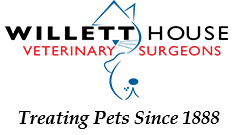Keyhole Surgery & Techniques
At Willett House we are always looking to improve our skills and to offer new techniques not readily available in all practices. That is why we were one of the first few practices in the country to offer keyhole surgery (laparoscopy), including the keyhole bitch spay for neutering female dogs.
We have invested heavily in laparoscopy as it provides a huge advantage for our patients compared with conventional surgery: It is minimally invasive which means a reduced surgical approach leading to the following benefits:
- Increased magnification and visualisation of the surgical field
- Reduced surgical time
- Reduced tissue trauma
- Reduced chance of bleeding during or post-operatively
- Reduced post-operative pain
- Small skin wounds with no skin sutures
- Less risk of post-operative complications such as infection and wound breakdown
- Faster recovery times meaning patients can be hospitalised for shorter periods and can often return to their normal exercise regime quicker.
The benefits of laparoscopy also mean that laparoscopic techniques can often be used in debilitated or compromised animals where conventional techniques maybe contraindicated.
In addition to the keyhole bitch spay, mentioned earlier, we offer a variety of other laparoscopic techniques all of which are only available in a handful of practices across the country. These include:
Diagnostic Laparoscopy
The use of laparoscopy to take biopsies of organs, such as the liver, kidney or lungs; or tumours/masses within the abdominal or thoracic cavities. See also Thoracoscopy section below.
Surgical Laparoscopy
The use of laparoscopic in performing surgical procedures including: keyhole bitch spay, cryptorchidectomy (castration of pets with abdominally retained testicles), adrenalectomy (removal of the adrenal gland) and hernia repairs.
Laparoscopic Assisted Surgery
Laparoscopic assisted surgeries allow the visualisation and exteriorisation of abdominal organs to allow surgical procedures to be performed outside the body wall. This offers all the benefits of laparoscopy whilst increasing the repertoire of potential surgical procedures that we can perform.
Such procedures include: prophylactic gastropexy (for the prevention of Gastric Dilation and Volvulus in at-risk breeds), bladder stone removal, intestinal biopsies and gastric and intestinal feeding-tube placements.
Thoracoscopy
Thoracoscopy or keyhole thoracic surgery in the dog and cat is a procedure which allows the placement of a rigid endoscope directly into the chest (thorax) to visualise the structures within and to allow biopsies to be taken of tissues, organs or masses; or to allow surgical procedures to be performed, such as, partial pericardectomy, pericardial window, lung lobectomy and thoracic duct ligation.
